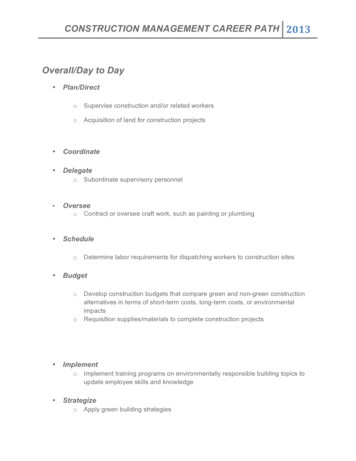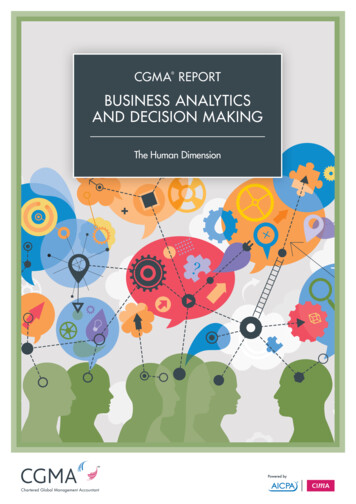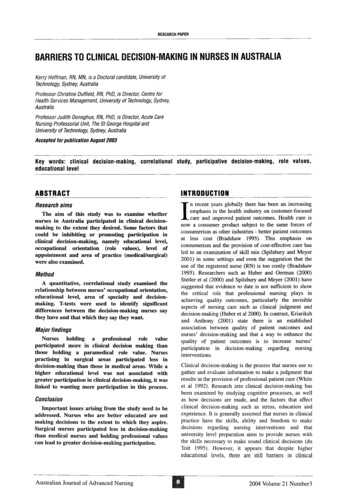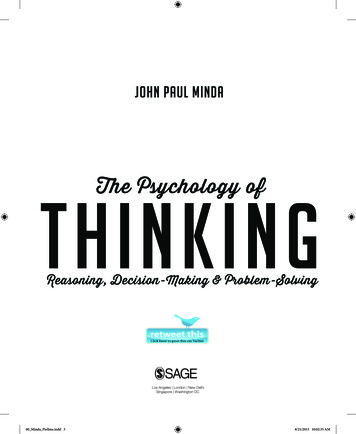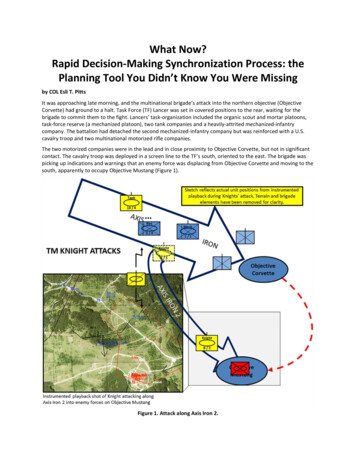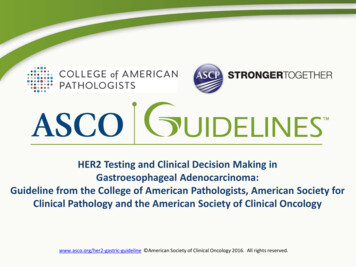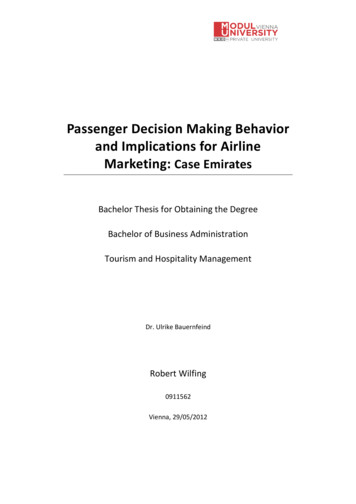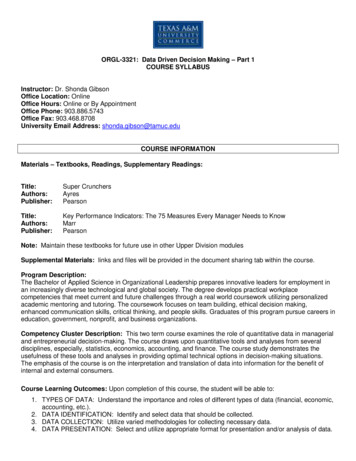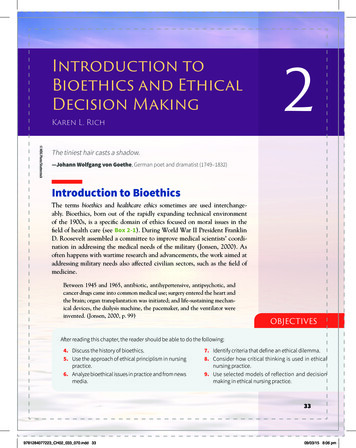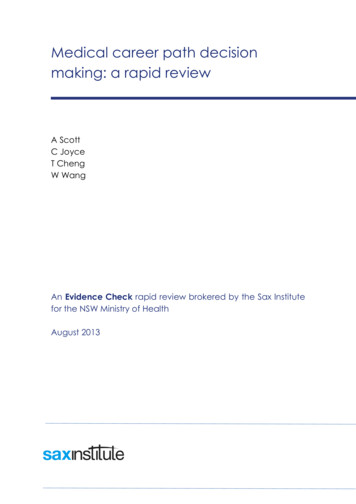
Transcription
Medical career path decisionmaking: a rapid reviewA ScottC JoyceT ChengW WangAn Evidence Check rapid review brokered by the Sax Institutefor the NSW Ministry of HealthAugust 2013
This rapid review was brokered by the Sax Institute for the NSW Ministry of Health.This report was prepared and written by:Anthony Scott, Catherine Joyce, Terrence Cheng and Wei Wang from the University of Melbourne andMonash University, Australia.August, 2013. Sax Institute, 2013.This work is copyright. It may be reproduced in whole or in part for study training purposes subject to theinclusion of an acknowledgement of the source. It may not be reproduced for commercial usage or sale.Reproduction for purposes other than those indicated above requires written permission from the copyrightowners.Enquiries regarding this report may be directed to:DirectorKnowledge Exchange DivisionSax .saxinstitute.org.auT: 61 2 9514 5950F: 61 2 9514 5951Suggested Citation:Scott A, Joyce Cl, Cheng T, Wang W. Medical career path decision making: an Evidence Check rapid reviewbrokered by the Sax Institute (http://www.saxinstitute.org.au) for the NSW Ministry of Health, 2013.Disclaimer:This Evidence Check review was produced using the Evidence Check methodology in response to specificquestions from the commissioning agency. It is not necessarily a comprehensive review of all literature relatingto the topic area. It was current at the time of production (but not necessarily at the time of publication). It isreproduced for general information and third parties rely upon it at their own risk.
Contents1EXECUTIVE SUMMARY . 51.1 Aims and background . 51.2 Findings . 51.3 Recommendations . 62Background and introduction . 72.1 Aims and questions addressed . 83Methods of review and papers retrieved . 94Results and analysis of evidence . 114.1 Can employers influence doctors’ career choices? .114.2 Can career planning and support influence career development andjob satisfaction? .134.3 When do doctors make critical career decisions? .134.4 What sources and modes of delivery of information influence career choices? .154.5 What influences specialty choice? .164.6 What influences decisions to work in rural and remote areas? .215Conclusions . 236References . 247Appendices . 30
1EXECUTIVE SUMMARY1.1Aims and background The aim of this rapid review is to examine factors influencing the career choices ofmedical practitioners In a context of rapid graduate expansion and more intense competition for prevocational and vocational training positions, it is important to understand what evidenceis available to inform policy interventions designed to influence career choices, includingthose specialties and locations which are predicted to be in shortage The literature from 2005 was reviewed, with a focus on Australian studies. TwentyAustralian studies and 189 overseas studies were found The evidence was of low quality. Most studies were either descriptive/qualitative or crosssectional surveys, with only a handful of poorly designed intervention studies.1.2Findings Three main groups of factors have been shown to be associated with career choice:othe characteristics, skills, and abilities of medical students and graduatesothe characteristics of undergraduate and postgraduate medical education andtrainingothe characteristics of alternative medical careers and jobs The preferences of medical students and doctors in training can potentially be influencedby the information they receive and their experiences throughout their training The sources of information they rely on are more likely to be informal; from peer groups,supervisors and experience in placements. There is some weak evidence that the qualityof supervision is associated with eventual career choices. There is also weak evidencefrom overseas that data on the availability of positions in each specialty training programand specialty may influence decisions The evidence of the impact of more formal career advice and support, and the role ofmentoring programs, is non-existent or too weak to make any conclusions Employers and government can alter the structure and nature of training and careers,and this can influence the availability and characteristics of career options. For example,Modernising Medical Careers in the UK shortened the length of medical training toaccommodate increasing numbers of graduates, but it remains unclear what effect thishas had on the quality and cost of training or on career trajectories Undergraduate placements can have some influence, especially where the quality ofsupervision is high and for those placements towards the end of medical school The early postgraduate years appears to be the time when most doctors in trainingdecide on their specialty training program in Australia. About 15% report being certain oftheir specialty at the end of medical school. There is evidence from the UK that those whoare certain of their choice early on are highly likely to end up working in that specialtySax Institute5
EXECUTIVE SUMMARY Most studies focused on specialty choice. Studies that asked respondents to rate theimportance of a list of factors were fairly consistent in their findings. For the factors thatwere actionable through policy change, work experience and the flexibility of hours werethe most highly rated, with financial aspects least highly rated. However, there was someevidence that financial aspects were most important for those who were uncertain abouttheir specialty and for those interested in surgery. The one Australian study that focusedmore on expected future job characteristics found avoiding on-call work, higher earnings,more procedural work, control over hours and academic research opportunities wereimportant determinants of specialty choice, with on-call work being the most importantfactor. Though student debt is less of an issue here than in the US, one Australian studyfound that the importance of earnings in influencing specialty choice was higher for thosewith more student debt The factors influencing career choice vary across specialties. For general practice, there isweak evidence that length and quality of clinical attachments may play a role Rural background has consistently been shown to be associated with rural practice froma range of studies across different countries. The influence of rural-based training andeducational experiences are also often cited, but the evidence to support this is weak.1.36Recommendations There is an urgent need to support high quality research and intervention studies ofchanges in medical education, career information sources, and policies influencingspecialty job characteristics on career choices. This requires not only investment inlongitudinal data collection that map and follow medical careers, but also investment inthe research skills of those undertaking such research Any interventions to influence the preferences of junior doctors should take place in theearly postgraduate years and should be properly evaluated Areas of intervention worth exploring further include:othe quality of supervision during training, including the role and nature of trainingfor supervisorsoproviding information on the chances of obtaining a specialty training placeothe provision of unbiased career information through trusted supervisors The strong association of rural practice with rural background suggests a stronger role forconsidering rural background in medical student selection The role and impact of rural-based clinical training needs to be more thoroughlyevaluated.Sax Institute
2Background and introductionMedical career paths are a key element in determining access to, costs and outcomes of thehealthcare system. The career decisions taken by medical practitioners between enrolment inmedical school and retirement determine the eventual skills, numbers, distribution and location ofpractice of qualified medical practitioners and, to an extent, of other health professionals whowork with them (e.g. nurses and allied health practitioners). The structure of careers, including thestructure and length of training, and the structure of promotion and rewards at different careerstages, can also provide incentives to influence not only career choices and trajectories, but alsothe costs and quality of care provided (Prendergast, 1999).Given the current consensus on the maldistribution of medical practitioners across specialties andgeographic locations, policy makers wish to know how they can influence career paths to leadto a more efficient and equitable distribution. Neither the preferences of medical graduates northe supply of training places reflects or is responsive to population health needs (HealthWorkforce Australia, 2013). This is especially the case in Australia, as record numbers of medicalgraduates are entering the training system and opportunities exist to persuade them to work inspecialties and areas of shortage.Increases in the numbers of medical graduates will not address maldistribution. This is likely to leadto oversupply unless other policies are also implemented to change career paths and persuademedical practitioners to work in specialties and areas of likely future shortage. There will be morecompetition for training places that will lead to junior doctors increasing their effort and/orspending longer in the system as salaried non-specialist doctors. As with the large expansion ofgraduates in the UK that led to Modernising Medical Careers, large-scale graduate expansion inAustralia will alter the career trajectories of junior doctors, as bottlenecks and increasedcompetition in the training system mean that all doctors cannot progress as quickly to specialiststatus, and some may not progress at all (Marshall, 2007). How these junior doctors will besupported requires an understanding of when and how career decisions are made.How medical practitioners make career decisions is based on a complex mix of their own skillsand abilities, the availability of career opportunities, and information about the expected futurecharacteristics and economic returns of different career paths. Career and specialty decisionsare dynamic in that individuals consider not only their current situation and past experiences, butalso broader life cycle factors, including family factors and expected future job characteristicsacross alternative career paths. The availability and characteristics of different career paths andjob opportunities are determined by employers (e.g. healthcare organisations and governments)and the opportunities for self-employment. Regulation has a strong role to play in the medicalcare career structure and labour market. For example, employer bargaining agreements definethe structure of salary scales, promotion, and the flexibility that employers have to attract andretain medical practitioners by offering higher remuneration, better working conditions, ordifferent types of jobs.Well-functioning labour markets also rely on good quality information about careers and the jobson offer to both candidates and employers. Markets with poor or inaccurate information will leadto employers and job candidates potentially making the wrong decisions. In addition, historicallyembedded earnings differentials between different career paths, peer networks, professionalstatus, and the culture of medical practice also have a strong role to play in medical careerchoice. Only some of the above factors can be influenced by policy in the short term.Sax Institute7
Background and introduction2.1Aims and questions addressedThe aim of this rapid review was to examine the literature on the factors influencing the careerchoices of medical practitioners. The results emphasise the existing Australian literature, set in thecontext of the larger overseas literature. The following seven questions were explicitly addressedin this review. There is some overlap between the questions, with some being general (Q1) andothers referring to more specific career stages (e.g. Q6 and Q7). Some of the evidence reviewedis applicable to more than one question.Question 1What evidence is there that doctors’ (or medical students’) career choices can be influenced bytheir employer (or potential employer)?Question 2What evidence is there that career planning, advice and support (including development ofcareer frameworks or matrices) has been successful in influencing career development and jobsatisfaction?Question 3When in their career pathway do doctors
Medical career paths are a key element in determining access to, costs and outcomes of the healthcare system. The career decisions taken by medical practitioners between enrolment in medical school and retirement determine the eventual skills, numbers, distribution and location ofCited by: 1Publish Year: 2013Author: A Scott, C Joyce, T Cheng, W Wang
